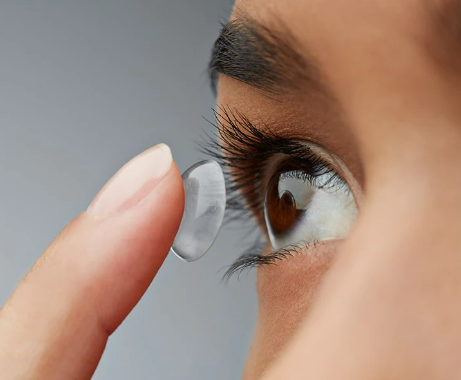A contact lens wearer may never see from his left eye again after a rare parasite infected him.
Doctors told Mike Krumholz it may have entered his eye after he napped in his contacts.
They initially thought that the infection was herpes, which has similar symptoms.
Mike Krumholz, 21, who lives in Florida, said that he napped for around 40 minutes after his shift at a children’s aftercare center on December 19 last year while wearing daily disposable contact lenses. He then had a shower, took his contacts out, and went to sleep.
A month later, doctors diagnosed him with a rare but serious eye infection that can cause blindness, called Acanthamoeba keratitis. Symptoms of the infection include: eye pain, redness, blurred vision, sensitivity to light, the sensation of something in the eye, and excessive tearing.
CDC advises users to remove contact lenses before any activities involving water such as showering, using a hot tub, or swimming
According to Krumholz, sleeping with contacts, even for a short time, may have enabled the microscopic Acanthamoeba organism to infect the outer covering of his eye, called the cornea.
Acanthamoeba keratitis, which is hard-to-treat and diagnose, is most common in contact lens wearers, but anyone can get it, according to the Centers for Disease Control and Prevention.
On average, one out of every 500 contact lens users develops a serious eye infection that can lead to blindness every year, the CDC states.
The CDC recommends taking steps such as removing contact lenses before any activities involving water such as: showering, using a hot tub, or swimming to prevent an Acanthamoeba keratitis infection. They also warn against sleeping in them as it can increase the risk of infection.
Dr. Anat Galor, a spokesperson for the American Academy of Ophthalmology, said that bacteria, fungi, or parasites that live in the environment can grow on contact lenses. Generally, they’re safe when worn and cared for properly, Galor, also a professor of ophthalmology at the University of Miami, said.
“It could just be a coincidence, and it could just be from showering in it, but my doctors believe that it’s from sleeping in it,” Krumholz, who shared his story to raise awareness, said.
Annually, one out of every 500 contact lens users develops a serious eye infection that can lead to blindness
“I know that I’m never gonna see fully again, but I don’t know how much of my vision I’m gonna get back,” he said.
Krumholz woke up the day after the nap with an itchy, “gunky” eye that felt worse in the daylight, and a runny left nostril. He took his allergy medications because he thought he was having a reaction to his family’s dogs, but that didn’t help.
The next day, he visited an optometrist, who immediately referred him to a specialist. That specialist thought his eye was infected with Herpes simplex, the virus that causes cold sores, and prescribed him antiviral medication. Acanthamoeba keratitis can be easily misdiagnosed as Herpes simplex because it causes similar symptoms, according to research.
Krumholz saw flashing lights like he was in a nightclub, but he was in his room
Despite treatment, his eye became so inflamed that it forced shut and he was screaming in pain.
“It got to the point where there was such severe flashing in my eye that it looked like I was at a nightclub when I’m just sitting in the dark in my room,” he said.
Sleeping in contact lenses can increase the risk of infection
Krumholz said he got scared and went to see another doctor, who also thought Herpes simplex virus was the culprit, and increased the number of antivirals he was on.
Doctors thought it was herpes, until he tested positive for a parasite infection
On January 31, over a month after he first noticed symptoms, doctors called him to say a scraping taken from his eye on January 17 tested positive for Acanthamoeba, and prescribed him new eye drops.
About a week later on February 10, doctors performed light therapy to stop the infection progressing and strengthen the cornea’s collagen, and took healthy tissue from the white part of his eye to try to heal the infected cornea.
After about a week, doctors told him that the eye was healing.
However, his symptoms left him “trapped” in his bedroom for weeks, shuttered off in the darkness, with hurricane blinds pulled down for about a month.
Krumholz said that he still gets excruciating pain that feels “like a lightning bolt” traveling from the back of his head to the top and into his left eye, lasting for around 30 minutes. It then eases to become “uncomfortable,” like “sand in your eye,” for the next 24 hours. An ice pack provides seconds of relief, he said.
“I take maybe one or two Advil per year, that’s how much I dislike medicine and now I take pain medicine every two hours or so,” he said. “It’s just the most extreme and uncomfortable pain ever.”
According to Krumholz, doctors told him that in the “best case” scenario he’ll be free of the parasite within six months, when he can undergo a corneal transplant to get rid of the part of his eye that was infected and likely damaged by the strong drugs used to treat it. In a tweet in March, he said the transplant should restore some of his vision.
The original article was published in Insider


